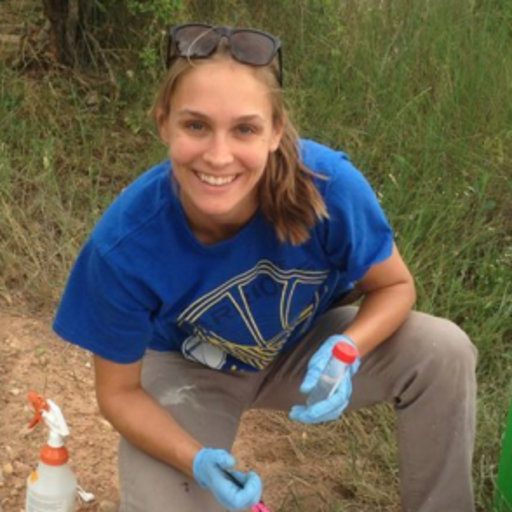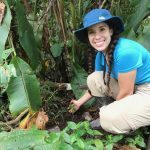Undergraduate mentoring and research

Hannah (Louie) Lu-Way and Hannah Horten conducting a pollination experiment on Calochortus tiburonensis.

Andrea Kuftin, Devon Thrumston and Geneva Lee in the lab
Mentoring philosophy
I am fortunate to have had several outstanding mentors, both as an undergraduate and as a PhD student. These relationships were the most rewarding and enjoyable elements of my educational experience and ultimately provided me with more encouragement than did excellent grades. I aim to provide such encouragement to the students I now work with in the classroom and on my research team. My goals for students are that they develop their skills as working scientists, that they practice working independently and collaboratively, and that they learn to critique their own work. In the process, I hope that they discover their own passions and interests and develop a feeling of ownership in our shared project. By developing a relationship of mutual respect, I hope to create an atmosphere in which we can support each other by freely and honestly exchanging feedback. Working with undergraduates on my research team is one of the things I most love about my job.
Jill Barrett Biology Research Program
The mission of the Jill Barrett Biology Research Program is to encourage the advancement of women in the biological sciences by providing research experience to undergraduates. The Jill Barrett Research Program was initiated in 1998, funded by the generosity of donors Richard and Elaine Barrett in honor of their daughter Jill, who graduated from Mills as a Biology major in 1993. After Jill graduated, she became an active conservation biologist, working to eliminate threats to endangered sea turtles, which remain at risk of extinction. Tragically, Jill lost her life in an accident in Greece while coming home from early morning of observation of sea turtles. Her family established the Jill Barrett Research Program in her memory.
The above description is excerpted from the Jill Barrett Research Program's webpage.
Current lab members
In addition to the outside funding noted by individual lab members, all of the folks mentioned have been awarded Jill Barrett Fellowships and UROP awards from Mills College. This support makes our research possible and we are grateful for it.
Alumnae with on-going collaborations

Julia Harencàr and I have been conducting research together since the beginning of the Calochortus research in 2012. She was instrumental in setting up the demography work, conducting our earliest tests of local adaptation and starting the molecular work for both species. While in my lab, she earned a Hardman Native Plant Scholarship from the California Native Plant Society. She completed her masters degree in Jenn Yost's lab at Cal Poly and is currently a PhD candidate in Kathleen Kay's lab at UC Santa Cruz.

Tatyana Soto joined the lab as a sophomore and instantly made herself invaluable. She collected demographic data in the field, conducted soil chemistry analyses, and eventually led the molecular work in the lab. She was also the recipient of a Myrtle Wolf fellowship from the California Native Plant Society. She is now earning her Masters in Chris Oakley's lab (Purdue).

Abra Schlotz is an avid and skilled botanist and is leading our new work on variation in mating systems. She currently works in environmental consulting.
Past lab members

Nia Rahman-Khan Arana spent their last two years at Mills on our team and, working alongside Tatyana, helped us have one of our most productive summers ever. In addition to all of their help in the field, they made invaluable contributions to the lab work. Nia is now a research associate in biomedical research and plans to go graduate school to study astrobiology.

Geneva Lee and I have been conducting research together for 4+ years. She led the effort to measure the effect of four consecutive population crashes (due to drought) on genetic diversity in one of the two remaining wild populations of Streptanthus glandulosus niger. Geneva earned a Myrtle Wolf Fellowship from the California Native Plant Society and a prestigious Summer Undergraduate Research Fellowship from the American Society of Plant Biology to support her research. She is applying to medical schools.

Brittany Burnett led the effort to experimentally determine how patch size, isolation and genetic diversity influence persistence of Streptanthus glandulosus niger. She and I are also working to determine if there is any genetic diversity hidden in the seed bank of Streptanthus.

Hannah Horten took over the reins from Brittany to lead the molecular work on Streptanthus in 2018. She also led the lab work measuring variation in serpentine soil chemistry (in collaboration with Kristina Faul). The soil chemistry work is the basis for our work using RADseqs to determine whether Calochortus tiburonensis' genetic structure corresponds to variation in soil chemistry. This is Hannah drinking coffee early one morning in Ecuador while we searched for (and found!) long-wattled umbrella birds. Hannah recently finished her Masters degree at the University of Finland, Helsinki.

Andrea Kuftin was part of the research team for 3 years and led the effort to measure the size of the seed bank in the two remaining wild populations of Streptanthus glandulosus niger, whether it is large enough to provide a buffer against extinction and/or contains any genetic diversity that is no longer present in the standing plant population.

Amina Khribeche was a member of the field team primarily responsible for collecting demographic data, conducting pollinator observations and reciprocal transplant experiments to test for local adaptation. This is Amina and a wild avocado seedling that she is clearly pleased to have planted at the Milpe reserve in Ecuador.

Tess Waxman and Bailey Meadows were members of team in the spring of 2021. Together they provided invaluable help with a literature review in support of our work on genetic diversity in Calochortus tiburonensis.

Kanya Hart was a member of the field team primarily responsible for collecting demographic data for both Calochortus tiburonensis and Streptanthus glandulosus ssp. niger.

Devon Thrumston was part of the research team for 3 years as a student and volunteered for the lab after graduating. While in my lab, Devon earned a Botany Research Scholarship from the Northern California Botanists to support her research. She now works for Genentech. She is also a talented cellist.



Emma Bolton, Hailey Sounart and Michelle Tran (L to R) were the Dream Team, led by Geneva Lee. They solved some of the early problems with the molecular work for both species and got that line of research off the ground.

Kelly Franson was part of the lab for 2 years. She collected a lot of Calochortus data, helped start the Streptanthus research and independently led a summer-long study on how fuel management (to reduce the risk of wildfire) affects chaparral communities and the birds that depend on it for nesting. She now works as a biologist for an environmental consulting firm in the Bay Area.

Chelsea Carminito filled a crucial role in the project on fuel management in chaparral and its effects on nesting song birds. She has an amazing singing voice and her musical background meant that she learned birds by song before she knew them by sight (an essential skill in chaparral) and, along with Kelly Franson, hiked up a steep ridge every morning at 4:00 a.m. for 2 months. She is now a PhD student in the Hobson lab at the University of Cincinnati.

Katie Young collected some of our first demographic data for C. tiburonensis. That same summer (2012), a wildfire swept through the largest population of C. tiburonensis and her attention shifted to studying the effect of fire on this plant and on exotic grasses, work that we continue today.

As a Barrett Fellow (2010), Ilana Stein conducted a field experiment testing how soil type mediates direct and indirect interactions between plants, pathogens and herbivores. This work was published in Biological Invasions. After graduating, Ilana took a position with Olofson Environmental, Inc. where she worked on invasive species management (primarily Spartina spp) and Endangered species (primarily the California clapper rail). Ilana is on the verge of completing her PhD in Todd Dawson's lab at UC Berkeley.